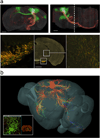Mapping brain circuitry with a light microscope
- PMID: 23722211
- PMCID: PMC3982327
- DOI: 10.1038/nmeth.2477
Mapping brain circuitry with a light microscope
Abstract
The beginning of the 21st century has seen a renaissance in light microscopy and anatomical tract tracing that together are rapidly advancing our understanding of the form and function of neuronal circuits. The introduction of instruments for automated imaging of whole mouse brains, new cell type–specific and trans-synaptic tracers, and computational methods for handling the whole-brain data sets has opened the door to neuroanatomical studies at an unprecedented scale. We present an overview of the present state and future opportunities in charting long-range and local connectivity in the entire mouse brain and in linking brain circuits to function.
Figures




References
-
- Golgi C. Sulla struttura della sostanza grigia del cervello. Gazz Med Ital (Lombardia) 1873;33:244–246.
-
- Ramón Y, Cajal S. Textura del sistema nervioso del hombre y de los vertebrados. Vol. 2. Moya; 1904.
-
- Felleman DJ, Van Essen DC. Distributed hierarchical processing in the primate cerebral cortex. Cerebral cortex. 1991;1:1–47. - PubMed
-
- Rockland KS, Pandya DN. Laminar origins and terminations of cortical connections of the occipital lobe in the rhesus monkey. Brain research. 1979;179:3–20. - PubMed
-
- Milham M, et al. Human Connectome review. Nature methods. 2013;XX:X.
Publication types
MeSH terms
Grants and funding
LinkOut - more resources
Full Text Sources
Other Literature Sources

